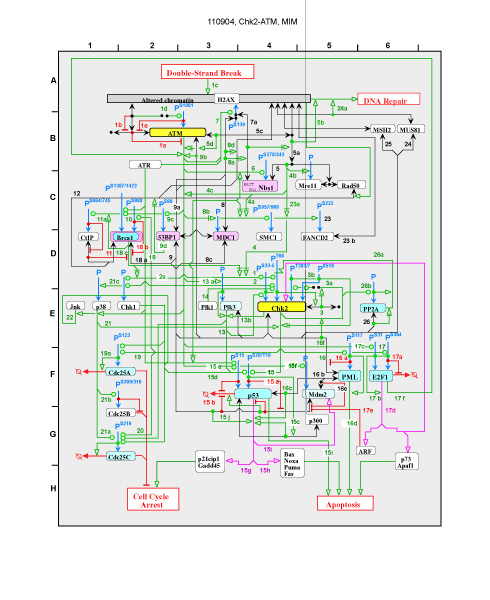Yves Pommier, Mirit I. Aladjem and Kurt W. Kohn
Implemented by : Margot Sunshine
To read the original paper describing this map and the symbols used, click here. This map has been updated since the article was published.
This MIM represents the ATM-Chk2 pathway. This pathway is activated by
double strand breaks that are recognized by the phosphorylated histone H2AX
and members of the MRN complex. The pathway includes the DNA damage sensor
kinases (ATM, ATR and DNA-PK), the adaptor BRCT proteins (Nbs1, Brca1, 53BP1, MDC1)
and the effector kinases (Chk2, Chk1, Plk3, JNK, p38). A characteristic of the ATM-Chk2
pathway is its apparent redundancy. For instance, ATM and Chk2 have common substrates
including p53, PML, E2F1, BRCA1, and Chk2 itself, suggesting that Chk2 (also known as CHECK2,
Cds1 in fission yeast, and Dmchk2 or Dmnk or Loki in the fruit fly) can act as a relay for
ATM and/or as a salvage pathway when ATM is inactivated. Some of the same substrates can
also be phosphorylated/activated by other pathways than ATM-Chk2, including Chk1, and the
polo kinases (Plk�s).
Most anticancer agents presently used clinically target the genome by damaging
DNA. Their tumor selectivity is probably due to tumor-specific defects affecting
cell cycle checkpoints and DNA repair, and enhancing apoptotic response in the tumor.
Functionally, Chk2 can activate both apoptosis (via p53, and PML) and cell cycle arrest
at S-phase (via cdc25A and cdc25C, p53, and BRCA1). Chk2 inhibitors can be used to enhance
the tumor selectivity of DNA damaging agents in p53-deficient tumors, and for the treatment
of tumors with enhanced Chk2 activation.
